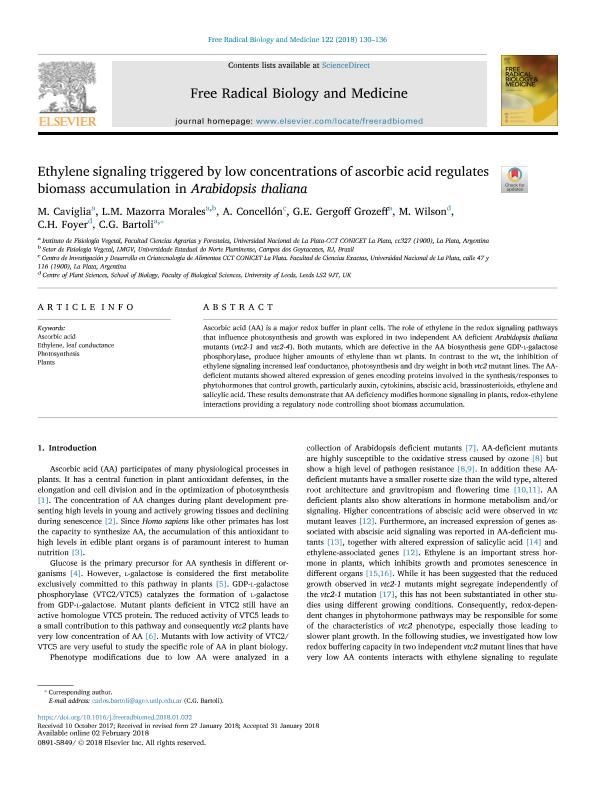Artículo
Ethylene signaling triggered by low concentrations of ascorbic acid regulates biomass accumulation in Arabidopsis thaliana
Caviglia, Marcos; Mazorra Morales, Luis Miguel ; Concellón, Analía
; Concellón, Analía ; Gergoff Grozeff, Gustavo Esteban
; Gergoff Grozeff, Gustavo Esteban ; Wilson, Michael; Foyer, Christine H.; Bartoli, Carlos Guillermo
; Wilson, Michael; Foyer, Christine H.; Bartoli, Carlos Guillermo
 ; Concellón, Analía
; Concellón, Analía ; Gergoff Grozeff, Gustavo Esteban
; Gergoff Grozeff, Gustavo Esteban ; Wilson, Michael; Foyer, Christine H.; Bartoli, Carlos Guillermo
; Wilson, Michael; Foyer, Christine H.; Bartoli, Carlos Guillermo
Fecha de publicación:
07/2018
Editorial:
Elsevier Science Inc
Revista:
Free Radical Biology and Medicine
ISSN:
0891-5849
e-ISSN:
1873-4596
Idioma:
Inglés
Tipo de recurso:
Artículo publicado
Clasificación temática:
Resumen
Ascorbic acid (AA) is a major redox buffer in plant cells. The role of ethylene in the redox signaling pathwaysthat influence photosynthesis and growth was explored in two independent AA deficient Arabidopsis thaliana mutants (vtc2-1 and vtc2-4). Both mutants, which are defective in the AA biosynthesis gene GDP-L-galactose phosphorylase, produce higher amounts of ethylene than wt plants. In contrast to the wt, the inhibition of ethylene signaling increased leaf conductance, photosynthesis and dry weight in both vtc2 mutant lines. The AAdeficient mutants showed altered expression of genes encoding proteins involved in the synthesis/responses to phytohormones that control growth, particularly auxin, cytokinins, abscisic acid, brassinosterioids, ethylene and salicylic acid. These results demonstrate that AA deficiency modifies hormone signaling in plants, redox-ethylene interactions providing a regulatory node controlling shoot biomass accumulation.
Palabras clave:
ASCORBIC ACID
,
ETHYLENE
,
PHOTOSYNTHESIS
,
PLANTS
,
LEAF CONDUCTANCE
Archivos asociados
Licencia
Identificadores
Colecciones
Articulos(CIDCA)
Articulos de CENTRO DE INV EN CRIOTECNOLOGIA DE ALIMENTOS (I)
Articulos de CENTRO DE INV EN CRIOTECNOLOGIA DE ALIMENTOS (I)
Citación
Caviglia, Marcos; Mazorra Morales, Luis Miguel; Concellón, Analía; Gergoff Grozeff, Gustavo Esteban; Wilson, Michael; et al.; Ethylene signaling triggered by low concentrations of ascorbic acid regulates biomass accumulation in Arabidopsis thaliana; Elsevier Science Inc; Free Radical Biology and Medicine; 122; 7-2018; 130-136
Compartir
Altmétricas



